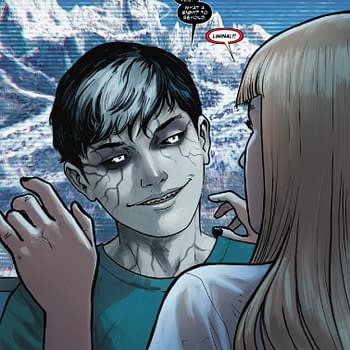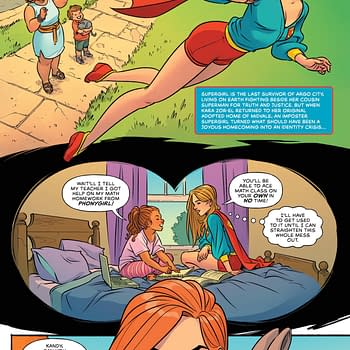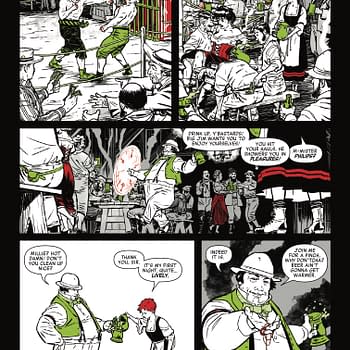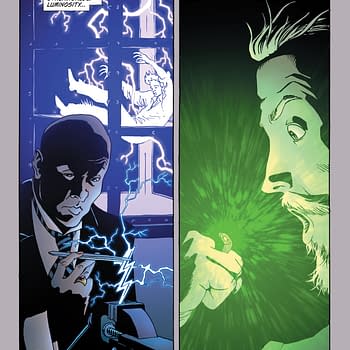Posted in: Comics, Recent Updates | Tagged: Comics, comixology, D4VE, entertainment, geof darrow, Henchmen, idw, Jamison Raymond, jason aaron, jason latour, Marvel Comics, men of wrath, Robbi Rodriguez, ron garney, ryan ferrier, spider-gwen
Thor's Comic Review Column – Spider-Gwen #1, Henchmen #2, D4VE #1, Men Of Wrath #5
This Week's Reviews:
Spider-Gwen #1
Henchmen: I, Henchbot #2
D4VE #1
Men of Wrath #5
Spider-Gwen #1 (Marvel, $3.99)
By Graig Kent
That's what I first thought when I spied the name "Spider-Gwen". Judging it on name alone it seemed ludicrous, positively dumb.
Once I read the concept, though, it seemed less so. An alternate universe where the radioactive spider bites Gwen Stacy instead of Peter Parker, and in Gwen's failing as a hero Peter dies? That's a nice spin, particularly for the Gwen Stacy character who, for so long, served only as the spectre of failure for the hero. I was a bit intrigued, but still, not being much of a Spider-fan at all, a respinning the Spider-Man origin didn't hold that much sway.
What hooked me then, through and through, was the costume. It's remarkable the drawing power of a well-designed costume. Costumes used to be designed with simplicity in mind, whatever made it easier for the artist to repeatedly draw the thing as quickly as possible. Intricate costumes take more time to illustrate and are more painstaking to color, both of which meant it took longer to produce an image, and back in the day, artists were working multiple books a month to pay their bills. Intricacy meant more time and less money. These days, where an artist can feel fed off of one book, 10 months of the year, intricacy isn't as big of a deal. Look at all the seams and piping in the costumes at the relaunch of the New 52. Simplicity kind of went out the window. One of the best recent designs/redesigns, Cameron Stewart's Batgirl, is chock-a-block with zippers and buttons and stitching. It looks fabulous but surely takes its toll on the illustrator reproducing it for multiple angles, panel after panel.
Spider-Gwen (who's really an alternate-universe Spider-Woman, but there's already a Spider-Woman comic, so the nickname sticks) has a beautifully simplistic costume that's largely black and white with duochromatic hot-pink and neon aqua highlights. It retains the striking bug-eyes of the traditional Spider-Man costume, and accents of webbing on the inner arms and inside her hood (yes! A hood!). The greatest touch is perhaps that the webbing is not drawn in with ink but coloured in by the colorist, no black lines. The aqua webs against the hot-pink pop, creating a dizzying 3-D effect that you can get lost in. The design inside the hood especially gives the effect that Spider-Woman's "spidey-sense" is constantly tingling as the webs radiate out from her head.
Yeah, the costume, designed by Robbi Rodriguez, is astounding, and (like Stewart's Batgirl) is certainly responsible for the immediate outpouring of fan support, leading to a fourth printing (and fantastic returns on the first printing) of her first appearance, and the immediate response of giving the character her own series. But the question was definitely would there be a payoff to this great character design? Would there be a character, and story, that would be worth investing in? Or is it all chrome, a shiny and attractive redressing of a familiar gimmick?
Spider-Gwen #1 achieves a rather remarkable feat for a first issue featuring ostensibly a new character, in that it feels lived in well beyond its years by the end of the first page! It opens with a "Previously" that is dense enough that I required no less than three readings to put straight the details (I missed out on Spider-Verse). Peter Parker is dead, Spider-Gwen is taking the heat. She saves her dad, Police Captain George Stacy, from an assassination attempt orchestrated by the Kingpin (Matt Murdock in this reality), and reveals her secret identity to him.
The book makes use of each of these details and piles more morsels in, including the Yancy Street Gang, who have started wearing white hoodies and defacing property in support of Spider-Woman, the Vulture searching to take some of the limelight for himself, Gwen's departure from her riot-grrrl band The Mary Janes (fronted by you know who), and her dad getting replaced on the Special Crimes Task Force by one Captain Frank Castle.
As with so many alternate universe iterations of popular heroes this one is littered with familiar faces in different contexts (see also beat cop Bejamin Grimm and District Attorney Foggy Nelson). It's an easy shorthand to make the world feel both familiar and distinct at the same time and writer Jason Latour negotiates it in pleasing ways that also compliment the story rather that distract it.
Latour's Gwen Stacy is indeed a fun character, containing the same wisecracking Spidey dialogue that resonates so strongly with readers of all ages. She's not a Peter Parker clone so so she has her own personal issues to deal with that differentiate her nicely. The rock band angle — particularly her estrangement from the band just as they hit it big — provides Gwen with a Josie and the Pussycats semi-private life (even if she's broke and unemployed) and a stable of supporting players that logically will hang together that isn't yet another school setting.
Of course we can't ignore Rodriguez' contribution to the book, which is considerable. His razor thin linework bristles with confidence, leaving the panels feeling detailed but uncluttered, his characters cleanly and uniquely realized, full of exaggerated gestures and oblique POVs, but it's all so endlessly attractive (even the ugly stuff like Aleksei and the Vulture). There's a Paul Pope influence at play but one that you can tell Rodriguez is already starting to shake. Add in Rico Renzi's absolutely gorgeous coloring, vibrant fluorescents and stark white contrasts, the pages dazzle the eyes, and at times the panels feel almost like animation stills.
It's often been said that Spider-Man can be anyone behind that mask, but usually that's in reference to his appeal with boys of all races. With Spider-Gwen, perhaps more than any Spider-Woman or Spider-Girl before her, it really gives girls the fantasy of being behind the mask, slinging the webs, and firing off a snarky remark.
Graig Kent is spending far too much time thinking about Star Wars lately, it's amazing he can get anything else done. He writes about movies and TV sometimes at wedisagree.blogspot.com and his first novel, Quarter City, can be read for free on Wattpat at the moment.
Henchmen: I, Henchbot #2 (Robot Paper, $3.50/hard copy, $0.99/digital copy)
By Cat Taylor
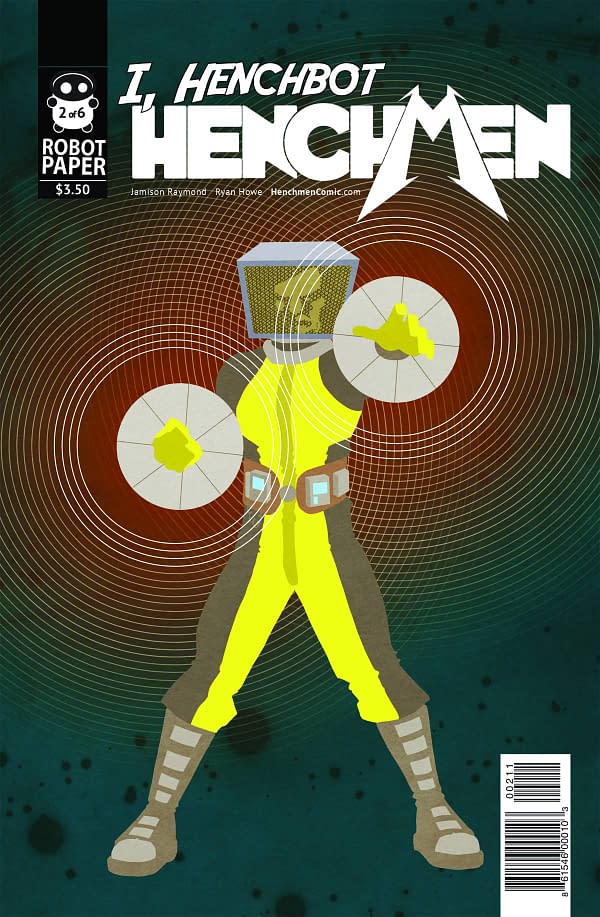
Jamison Raymond shows a knack for telling an entertaining story that is both simple in execution and original in the spin that it puts on the henchmen who serve the super-villains. Raymond takes a light-hearted, tongue-in-cheek approach to the subject matter, seemingly using the old Adam West Batman TV series as his inspiration for the character designs. However, even with the generally fun tone of the story, the main character, Gary, comes off as realistic example of someone whose hard luck would make him desperate enough to sign up to work with super-villains.
Gary, as a total outsider to the super-hero/super-villain culture, is able to quickly identify the absurdity of the way the villains handle themselves and the way their henchmen go along with the plans that are obviously doomed to failure. Simply by applying a little common sense, Gary is able to keep himself from suffering the same defeats and arrests that the other henchmen experience, but this also makes him into a target for the super-villains when word gets out about what he's doing. At this point, it's unclear if the villains are angry at Gary for not "throwing himself on his sword," as henchmen are expected to do when serving the arch-villain, or if they are simply upset that he is a rebel who is disturbing the tried-and-true traditions of the established hero/villain "dance." In either case, I suspect that Gary will end up as a major villain himself due to his ability to apply logic and avoid a lot of the cliched super-villain pitfalls. In a way, the concept of the desperate regular guy who gets into crime that is over his head and manages to be an unexpected success is similar to Breaking Bad, but Henchmen avoids being grim and gritty and takes on a completely different tone.
Raymond has found a great match for his writing style in the art of Ryan Howe. Howe appears to have a few more publications under his belt than Raymond, but it's still a relatively small body of work and all of it has been for independent publishers. He has a clean style that captures the personalities of the ordinary people and the appearances of ridiculous-looking super-heroes and villains equally well. His work is somewhat reminiscent of Dave Gibbons but I'm reminded even more of the old daily newspaper comic strips like Steve Canyon, if anyone remembers those.
I was really happy that Comixology finally put up another issue of Henchmen. However, it would be nice if they were more consistent and would post the entire series on a regular basis. The problem with these independent online comics is that they aren't exactly easy to find without a lot of due diligence. Old comics readers like me are used to going into a store on Wednesdays and seeing what's on the shelves. While the internet makes comics more accessible and gives us a greater choice, it's actually a situation of diminishing returns. After all, it's impossible to search through every comic book that's available on the internet. Also, since the publishers put up new issues whenever they feel like it, there isn't a regular day for new releases. Perhaps this is a change that old-timers like me need to get used to. We'll see. Regardless, it's a nice surprise on the occasions when I do find a fun and original online comic like Henchmen.
Cat Taylor has been reading comics since the 1970s. Some of his favorite writers are Alan Moore, Neil Gaiman, Peter Bagge, and Kurt Busiek. Prior to writing about comics, Taylor performed in punk rock bands and on the outlaw professional wrestling circuit. During that time he also wrote for music and pro wrestling fanzines. It hasn't been a terribly great day for him but it's nothing a good punch in the the jaw won't fix. You can e-mail Taylor at cizattaylor@hotmail.com.
D4VE (IDW)
By Adam X. Smith
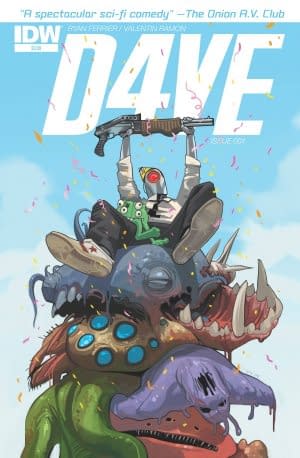
However, it's a wise man that profits by his previous mistakes, and as the last few weeks have proven, supporting independent comic publishers who that are willing to provide free review copies has its advantages. However, since I've not given IDW much custom in a while, I thought it's timely to check out one of their recent debuts.
Previously published by Monkeybrain Comics last year and picked up by IDW for print, D4VE follows the life of the titular robot, a formerly badass killbot who is experiencing a midlife crisis, in a future where the rise of The Machines lead to not only the extinction of all organic life in the universe, but also existential ennui for the robots that survived the fall of mankind only to end up living boring, mechanical lives. Stuck in a dead-end job and a loveless marriage, D4VE constantly daydreams of his former glory – if only there were a new species of alien that could show up and give him something to direct his frustration at?
So yeah, it's American Beauty via the Second Renaissance sequences from The Animatrix with a little bit of Futurama/Archer-level humour thrown in, if you want to be lazy and reductive. That might not sound like a world-beater, but as a story Ryan Ferrier does a decent enough job of setting up the pieces for something interesting down the line, and the real star of the show is Valentin Ramon's exceptionally detailed artwork that takes clear stylistic cues (as well as new levels of attention to detail) from Geof Darrow. The scene of D4VE being dragged by his co-worker to an all-robot strip club named the Lube Tunnel (natch) stands out for the amount of detail on display from the various robot strippers and clientele, without becoming outright fanservice.
Of course, knowing ahead of time that this is yet another five-issue miniseries that's being recycled-ahem, re-released does run the risk of making the reader feel that it's somehow less fresh and vibrant for it, but given that I went in not knowing this and was still impressed it shouldn't really factor too greatly into whether or not you enjoy it on its own merits. Indeed, it's nice to see the likes of IDW, whose output overwhelmingly consists of licensed material based on existing franchises, pulling small press work up by its bootstraps into wider distribution, given that lots of similar work by small publishers rarely sees physical release and relies on digital sales and good critical reception to make any impact at all.
So yeah, that's two weeks in a row I've reviewed comics with leetspeak in the titles, both of which are re-releases by independent publishers. Maybe if I state the intention of writing up a third one next week, my copies of Ultimate Spider-Man and Miracleman will arrive early. I'm not counting on it, but there's always hope.
Live long and prosper.
Adam X. Smith is currently trying to force himself to watch the Frost/Nixon interview tapes in their entirety. It's not going well.
Men of Wrath #5 of 5 (Icon, $3.99)
By Jeb D.
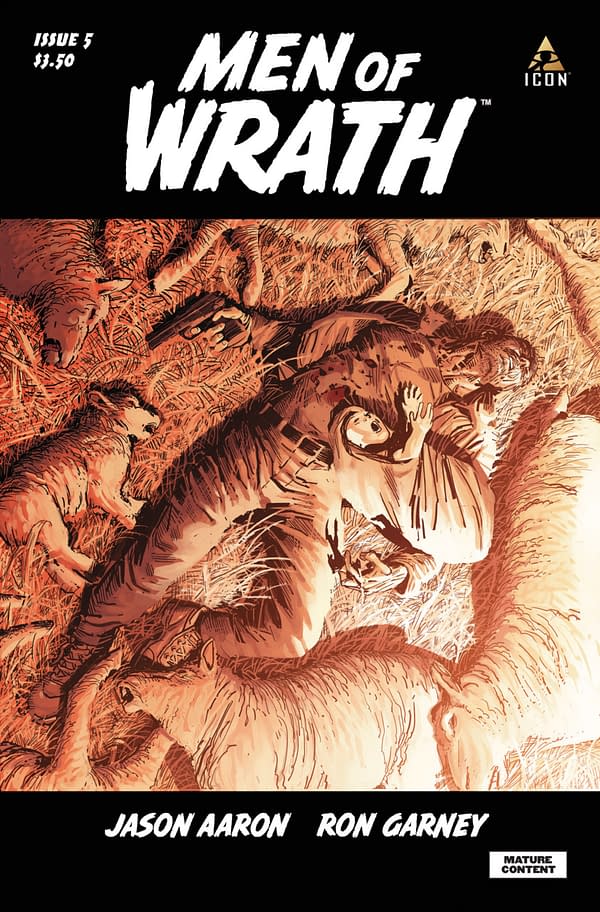
Men of Wrath is the history of Alabama's Rath family, whose male descendants carry a blood taint that inevitably drives them to the most heinous of violence. Aaron's other crime comics like Scalped and Southern Bastards have earned him comparison with novelists like Elmore Leonard and Lawrence Block; Men of Wrath feels more like something out of Jim Thompson or James M. Cain. I know nothing about Aaron's upbringing, but I'd be willing to bet on a strong exposure to the Hebrew Bible / Old Testament. "Sins of the Fathers" is New England preacher talk for "Original Sin," and in this bleak tale of the Rath lineage, from Isom to Ruben, Aaron assails that inevitability: there's no shrug or acceptance of "God's Will": there's nothing godly in the madness that taints the blood of the men of the Rath lineage, and the only hope of escape lies outside the scope of what God has made of these men.
The last page of issue #4 held out this series' last glimmer of hope. Within the first few pages of issue #1, Ira Rath, our nominal protagonist, commits a crime sufficiently monstrous to ensure that we'll never be more than reluctant witnesses to his journey. Our empathy shifts to his son, Ruben, though we're reminded over and over again of his helplessness to escape even the mundane evils of the world, much less his ordained fate. At the end of issue 4, Aaron brings him face to face with Polk and his gang, in a situation so hopeless that our instincts as long-time comics readers assume that the moment has arrived: Ruben will finally uncover the murderous Rath within himself; or perhaps we'll see a rallying of forces, a "Millenium Falcon returns at the crucial moment" appearance from Ira.
Aaron denies us any of that: we don't even get the catharsis of confrontation, as issue #5 opens in the grimly inevitable aftermath of Ruben's fecklessness. Nothing resembling the reclamation or salvation of these souls plays out over the next two dozen pages: just blood and death, up until the very final moments. The conclusion is almost like a grim shaggy-dog joke played on the dying Ira: it's the only hint of redemption in the series, but one specifically denied him.
I hope I don't seem to be devaluing the contributions of Garney and colorist Matt Milla to the story: with all due respect to artists like R.M. Guera and Jason Latour, this is the most visually arresting Aaron comic since The Other Side: it's not a book that features violence, it's a book about it, and while Garney and Aaron make some nice artistic choices with the storytelling (like the black pages with Ira's narrative boxes floating in midair), it's the immediacy of the horror, blood, and death that hit the reader again and again, but with an expansiveness that we more often associate with great superhero fight scenes rather than crime comics. I have no reason to think either of these "inspired" Garney, but I was reminded of the immediacy of Klaus Janson's work on Daredevil: End of Days, and the grim horror of Deadwood's confrontation between Dan Dority and The Captain.
It's rough stuff, and if Men of Wrath isn't quite as hard to take as, say, Crossed, it's still a series that's going to be difficult for a lot of readers to get into (I don't know that the word "enjoy" would even apply). But, as I say, it goes out the way it came in, and earns every drop of blood it sheds.
Jeb D. already misses Leonard Nimoy: he once played football in Nimoy's backyard with him and his kids.











